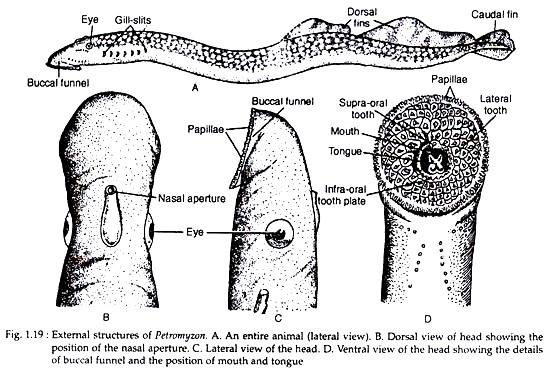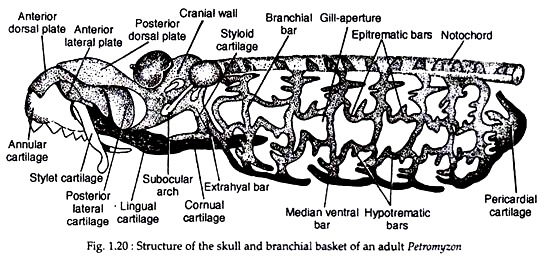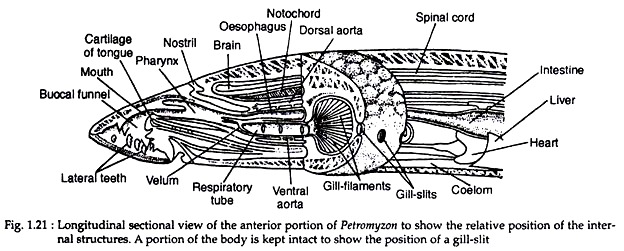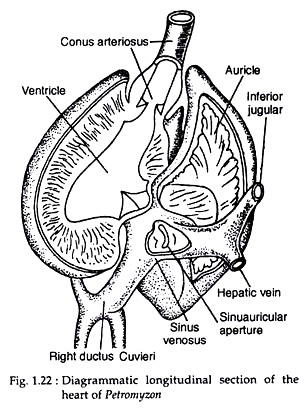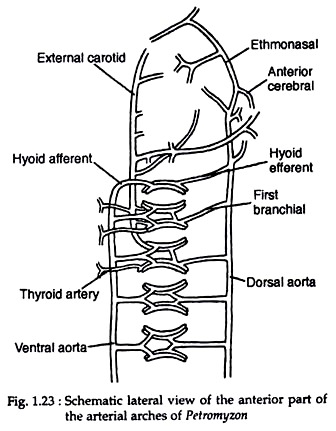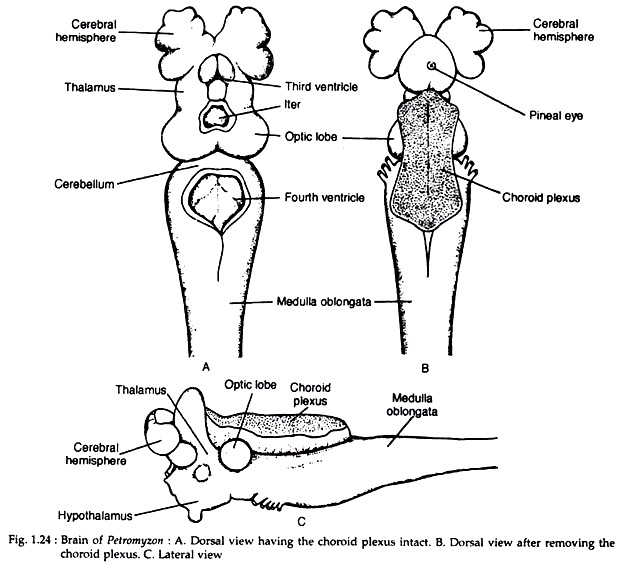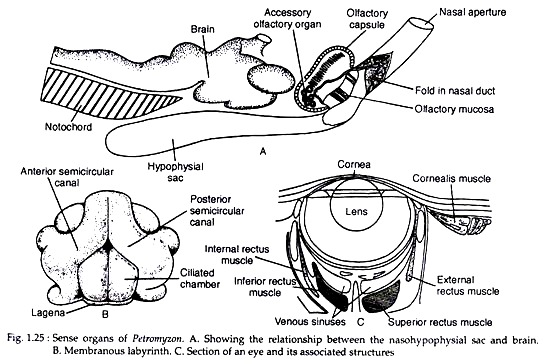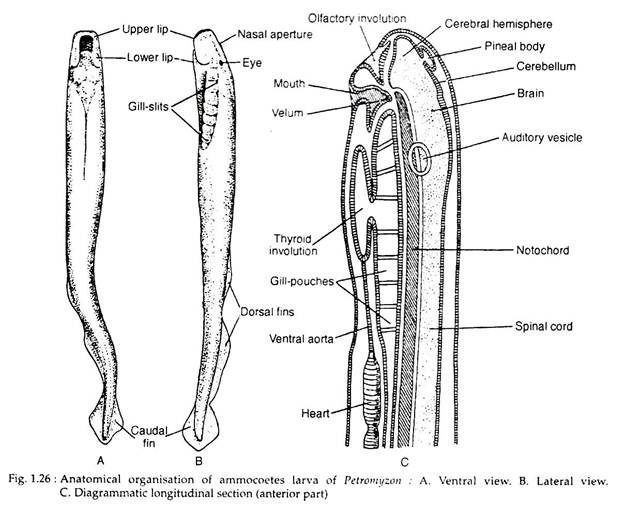In this article we will discuss about:- 1. Habit and Habitat of Lampreys 2. External Structures of Lampreys 3. Body Wall and Musculature 4. Locomotion 5. Skeletal Structures 6. Digestive System 7. Respiratory System 8. Circulatory System 9. Nervous System 10. Excretory System 11. Reproduction 12. Development.
Contents:
- Habit and Habitat of Lampreys
- External Structures of Lampreys
- Body Wall and Musculature of Lampreys
- Locomotion of Lampreys
- Skeletal Structures of Lampreys
- Digestive System of Lampreys
- Respiratory System of Lampreys
- Circulatory System of Lampreys
- Nervous System of Lampreys
- Excretory System of Lampreys
- Reproduction in Lampreys
- Development of Lampreys
1. Habit and Habitat of Lampreys:
Lampreys have almost a worldwide distribution. All of them are predators and live on fishes, turtles and many other aquatic animals. They are often referred to as quasi-parasitic which is not true in biological sense.
They usually remain attached to other fishes or stones by the help of suctorial buccal funnel which acts as a vacuum cup. While attached to the fishes, they rasp the flesh by the horny teeth on the buccal funnel and ‘tongue’ apparatus.
ADVERTISEMENTS:
Lampreys usually live in the sea and migrate to the river for the purpose of spawning. After spawning they usually die. For spawning, they select the bottom where both stones and sands are present. By the action of the suctorial mouth, they arrange the stones in such a fashion that a small depression is produced at the centre and lay eggs in it.
Two distinct phases are recognised in the life-history of the lampreys:
(1) Adult stage:
In this stage, lampreys are marine and possess suctorial mouth. They are carnivores and feed on other fishes.
ADVERTISEMENTS:
(2) Larval stage:
The larval stage is represented by ammocoetes larva which inhabits the fresh water. It remains buried in the mud and devours microorganisms. This larva resembles closely the adult Branchiostoma.
2. External Structures of Lampreys:
ADVERTISEMENTS:
The adult lamprey has an eel-like cylindrical body (Fig. 1.19A). The upper side of the body is usually dark and the lower surface is white. The surface of the body is smooth and slimy. Scales are absent. Body is divided into three regions—head, trunk and tail. The head and trunk are cylindrical and the tail is more or less laterally flattened.
Paired fins are absent. There is a median dorsal fin which is divided into two unequal parts by a notch. A caudal fin is present which is continuous with the posterior part of the dorsal fin. A small opening called anus is present on the ventral side at the junction of the trunk and tail. The anus lies in a slight depression.
Immediately behind the anus a small papilla is present. This papilla is pierced by the urinogenital aperture at its extremity. The fins are supported by cartilaginous fin-rays. These rays are fused at their basal ends along with the membranous covering that surrounds the notochord and nerve cord.
The head region is characterised by the development of a special cup-like structure called buccal funnel. The rims of the buccal funnel are beset with papillae. Numerous small horny teeth are present inside the cavity. The teeth on the upper and lower sides of the mouth fuse to form tooth plates which are designated as supra-oral tooth plate and infra-oral tooth plate, respectively.
The mouth is surrounded by concentric rows of lateral teeth. The mouth is a circular opening situated at the bottom of the buccal funnel. A special tongue apparatus is placed just below the mouth (Fig. 1.19D). The tongue is a prominent structure and bears horny teeth. On the dorsal side of the head there is a single secondary median nasal aperture (Fig. 1.19B).
Just behind the nasal openings, there is a yellow spot indicating the position of internal pineal eye. The paired eyes are well-developed (Fig. 1.19C). Seven pairs of round gill openings are present on the posterolateral sides of the head and the anterior part of the trunk.
3. Body Wall and Musculature of Lampreys:
The skin is soft. The epidermis is composed mostly of unicellular gland cells that produce slimy secretion. In addition to the typical gland cells, two other special types of gland cells have been encountered.
They are:
ADVERTISEMENTS:
(i) Granular cells of unknown function and
(ii) Club cell (kolbenzelle).
The club cells are elongated with hyaline cytoplasm. The dermis is composed of bundles of collagenous and elastic fibres. These fibres are arranged in a circular fashion. Between the dermis and body wall musculature, there lies a subcutaneous layer containing pigment cells, blood vessels and fatty tissue.
The pigment cells or chromatophores are star-shaped cells which have the power of migration and they are also present in the dermis. The pigments contained in the chromatophores are capable of changing position under different conditions of illumination.
The trunk musculature is well-developed. The muscles are arranged to form myomeres, i.e., there are series of myotomes separated by myocommas. The myotomes are W-shaped muscle blocks and the muscle fibres composing the myotomes run longitudinally. The muscle fibres are striated. The myotomes are divided into dorsal and ventral parts by horizontal septum.
4. Locomotion of Lampreys:
Lampreys swim by the activity of the myotomal longitudinal muscle fibres. Swimming is effected by producing waves of curvature down the body, alternately on each side. In lampreys, the waves are very short in comparison to the body length, as a consequence progression is not so rapid. Expulsion of water through the gill openings like jets also helps in progression.
5. Skeletal Structures of Lampreys:
The axial skeleton consists of a lowly developed skull, persistent notochord and collection of cartilages.
(i) Notochord:
The notochord is composed of large vacuolated notochordal cells and remains enveloped by a thick fibrous notochordal sheath. This is further surrounded by another connective tissue layer which covers the spinal cord and remains connected with the myocommas.
Within the connective tissue layer there are scattered thickening of cartilaginous elements. These are compared with the vertebrae. The cartilage consists of large cells embedded in a matrix of chondrin. Many slender cartilaginous rods extend dorsally and ventrally to support the median fin.
(ii) Skull:
The skull is very peculiar and primitively built. Its floor is composed of a basal plate which is composed of paired parachordals and trabeculae. Attached with the basal plate there are pieces which form an incomplete cartilaginous box enclosing the brain and the special sense organs. In front of the cranium, a large aperture is left due to the free posterior parts of the trabeculae.
This aperture is called basicranial fontanelle and through this aperture the pituitary pouch passes. The side wall of the cranium is strong but the roof is exclusively composed of tough membranous fibrocartilage excepting a narrow transverse bar. The two compact auditory capsules are united with the posterior end of the basal plate.
The olfactory capsule is an imperfectly paired plate which supports the posterior wall of the olfactory sac. This capsule is united with the cranium by fibrous tissue. On each side of the basal plate, there lies the sub-ocular arch to support the eye.
A slender styloid process hangs from the sub-ocular plate. Each styloid process is connected with a small cornual cartilage. The cranium is attached with the skeleton that supports the gills and buccal funnel (Fig. 1.20).
(iii) Branchial Basket:
The branchial basket is composed of nine irregular vertical and cartilaginous branchial bars or rods on each side. The first vertical branchial rod is situated just posterior to the styloid process, the second is in front of the first gill slit and the rest are just posterior to the remaining gill slits.
The vertical bars are connected by the longitudinal bars. The posterior part of the branchial basket is extended to form a cuplike pericardial cartilage to accommodate the heart. The buccal funnel is supported by a ring-like annular cartilage. An elongated lingual cartilage supports the tongue.
6. Digestive System of Lampreys:
The mouth is situated immediately above the tongue inside the buccal funnel. The buccal funnel is a specialised cup-like depression which acts as a sucker. Numerous teeth are present in the buccal funnel. These teeth develop as horny epidermal thickenings having cartilaginous support. The teeth that are borne on the tongue are elongated and sharply pointed.
The teeth are capable of being replaced, if lost. Special sets of muscles operate the buccal funnel and the tongue apparatus. Lampreys can attach with the body of other fishes by producing a vacuum inside the buccal funnel. This is caused by the action of a large cardioapicalis muscle.
The muscle is connected posteriorly with the pericardial cartilage and the anterior end is prolonged as a lingual tendon to attach with the tongue. The vacuum cup is produced inside the oral cavity by the pulling of the tongue backwards by the contraction of the cardioapicalis muscle. The release of the sucker is effected by the contraction of an annular muscle running along the margin of the buccal funnel.
The mouth leads into a spacious buccal cavity which is communicated behind with two passages. The dorsal passage is called the gullet or oesophagus and the ventral one is the respiratory tube (Fig. 1.21). The respiratory tube is closed behind and leads into seven branchial or gill pouches.
The opening of the respiratory tube is guarded by a velum with velar tentacles. The velar apparatus keeps the digestive part completely separated from the respiratory tube when the animal feeds. The oesophagus leads directly into a straight intestine by a valvular aperture.
The anterior portion of the intestine is slightly dilated. This may represent the stomach. True stomach is absent in lampreys. The un-convoluted intestine passes to the anus. In the lumen of the intestine, a typhlosole is present which follows a spiral course and thus gets the name spiral valve.
Digestive glands:
These are well-developed in lampreys. A pair of pigmented sacciform structures, present inside the hypobranchial muscles, is regarded as buccal glands or salivary glands. But the nature of the secretion of these glands is still unknown. Each gland has a folded wall and the secretion is poured through a duct which opens below the tongue.
The secretion contains anticoagulant which prevents coagulation of blood during feeding. The liver is a voluminous bilobed structure. The gallbladder and bile duct are present in the larval stage, but they are absent in the adult. There is no definite pancreas, but patches of cells in the anterior part of the epithelium of intestine are compared with the pancreatic acini of the higher vertebrates.
The secretory cells are of two types:
They are: zymogen cells and cells in the follicles of Langerhans. The zymogen cells secrete pancreatic enzymes which are largely tryptic in nature. The endocrine function of the cells of follicles of Langerhans has also been experimentally established. If the tissue is destructed, a marked rise in blood sugar level is recorded.
Mode of feeding:
The actual mode of feeding in lampreys is not known. While attached with the body of fishes, they eat the flesh by rasping with the tongue apparatus. The intestine of a freshly detached lamprey is found to be filled with blood which also indicates their sanguinivorous habits.
7. Respiratory System of Lampreys:
The respiratory system consists of seven pairs of gills or branchial pouches or branchial sacs. The gill pouches open directly into the respiratory tube and have no direct connection with the enteric canal. Each gill pouch has an appearance of a biconvex lens. The inner wall is folded to form numerous gill lamellae and the outer wall is highly muscular (Fig. 1.22).
The gill pouches are separated from each other by interbranchial septa. Each gill pouch in lampreys opens independently to the exterior. Seven pairs of external gill pores are visible on the two sides of the body. Water enters into the respiratory tube through the gill pouches and passes out through the same route.
The branchial skeleton is elastic. The branchial basket is compressed by the contraction of the muscles to throw water like jets through the gill openings, while during inspiration the branchial basket expands. The gaseous exchange occurs inside the gill pouches.
8. Circulatory System of Lampreys:
The circulatory system is well-developed. There is no definite lymphatic channel in lampreys. The heart is an S-shaped structure situated behind the gills. It develops in the larva as a straight tube which becomes elongated and as the space is limited it becomes S-shaped.
It is composed of four chambers— one sinus venosus, one auricle, one ventricle and one conus arteriosus (Fig. 1.22). The heart is enclosed by a pericardium which is supported by a cartilaginous plate. The sinus venosus is a thin-walled chamber and leads into a thin-walled auricle lying above the sinus venosus. The auricle opens into the thick-walled ventricle.
The blood of lamprey is red in colour and haemoglobin remains inside the red blood corpuscles. These corpuscles are nucleated and circular in outline. The white corpuscles are closely similar to the lymphocytes and polymorphs of higher vertebrates. The blood-forming tissue is present in the spiral valve, kidneys and spinal cord.
Arterial System:
From the ventricle a large ventral aorta runs anteriorly between the gill pouches. The base of the ventral aorta is slightly dilated. The ventral aorta gives eight afferent branchial arteries to the gill pouches. The afferent branchial arteries break up into capillaries in the gills. From the gills, the blood is collected by eight efferent branchial arteries (Fig. 1.23).
Each of the afferent and efferent branchial arteries supplies the posterior hemi-branch of a gill pouch and the anterior hemi branch of the next. The efferent branchial arteries open into the paired dorsal aortae.
These paired aortae run backward and then unite to form a single median dorsal aorta which, in turn, gives series of segmental arteries to the myotomes. Diffused chromaffin cells are present on the segmental arteries (also present on the segmental veins) which represent diffuse adrenal medulla.
The secretion closely resembles mammalian adrenalin. Special arteries from the unpaired dorsal aorta supply blood to the gut, kidneys and gonads. Most of the arteries except the efferent branchial and renal arteries are provided with valves at the point of origin.
The presence of the valves is significant, because these valves help in reducing the pressure of the blood in most of the arteries. The blood flows anteriorly through the ventral aorta and backwardly through the paired and unpaired dorsal aortae.
Venous System:
The venous system of lampreys consists of true veins and a complicated network of venous sinuses. The blood from the tail region is carried by a large caudal vein. This vein divides anteriorly into two posterior cardinal veins just at the point of the entrance into the abdominal cavity.
The cardinals collect the blood from kidneys, gonads and myotomes and, ultimately, open to the heart by a single ductus Cuvieri on the right hand side. The left ductus Cuvieri is absent in adults, although both are evident in the larval stage. The blood from the anterior region of the body is conveyed to the heart by a pair of anterior cardinal veins.
Besides these anterior cardinals, a large median inferior jugular vein drains blood from the musculature of the buccal funnel and gill pouches. There is no renal portal vein, but a hepatic portal vein draining blood from the gut enters into the liver through a contractile portal heart.
A very simple portal system is present which connects the hypothalamus with the pituitary. From the liver, the blood is carried to the heart by hepatic veins. Besides the veins, there are special networks of venous sinuses specially in the head region. The branchial sinuses consist of three longitudinal channels.
These are:
(1) Ventral branchial sinus or ventral jugular sinus.
(2) Inferior branchial sinus situated below the gill pouches.
(3) Superior branchial sinus lying over the gill pouches. All these branchial sinuses are interconnected through the gill bars.
9. Nervous System of Lampreys:
The nervous system of lamprey is well- developed and the description of this system will represent an introductory account of the typical vertebrate nervous system.
Brain:
The neural tube becomes modified anteriorly into a complicated brain and the posterior part transforms into the spinal cord. The brain is divided into three primary parts — forebrain or prosencephalon, midbrain or mesencephalon and hindbrain or rhombencephalon.
The prosencephalon is mainly connected with the sense of smell, the mesencephalon with the sight and the rhombencephalon with the acoustic-lateral and taste-bud systems. The prosencephalon is sub-divided into telencephalon and diencephalon. The telencephalon consists of cerebral hemispheres (cerebrum) and olfactory lobes.
The diencephalon remains posterior to the cerebral hemispheres. The mesencephalon forms the optic lobes. The rhombencephalon is divided into two parts — an anterior metencephalon transforming into a cerebellum and a posterior myelencephalon or medulla oblongata. The brain is covered externally by a vascular membrane called choroid plexus or tela choroidea (Fig. 1.24).
The prosencephalon consists of a pair of small cerebral hemispheres and a pair of olfactory bulbs. The olfactory bulbs give paired olfactory nerves to the nasal capsule. The olfactory bulbs contain small ventricles. The cavities of the cerebral hemisphere are called lateral or first and second ventricles.
The lateral ventricles are in communication with the third ventricle or diacoel (cavity inside the diencephalon) through the foramen of Monro. The diencephalon has a membranous roof which protrudes outwards as a conspicuous saccus dorsalis. The lateral walls are known as thalamus and the ventral part is called hypothalamus.
The hypothalamus is well-developed. It bears inconspicuous inferior lobes and indistinct saccus Yasculosus, The supraoptic nucleus of the hypothalamus sends nerves to the par nervosa of the anterior pituitary lobe. On the ventral side of the diencephalon lies the simple crossing of optic nerves which do not form chiasma.
The velum transversum, that demarcates the anterior end of the diencephalon of the vertebrate brain is absent. The midbrain is represented by two optic lobes. Between the optic lobes lies a membranous choroid plexus which is fused with plexus lying over the fourth ventricle, i.e., the cavity of the myelencephalon. So the choroid plexus thus extends into the ventricles at three places.
The cerebellum is a small transverse lobe anterior to the medulla oblongata which is the largest and well developed part of the brain in lampreys. The third and the fourth ventricles are communicated through a duct passing through the midbrain. This duct is called the iter or aqueduct of Sylvius.
Spinal Cord:
The spinal cord is a dorsoventrally flattened band-like structure. The spinal cord in lamprey is peculiar as no blood vessel is present within it. The nerve cell bodies are localised towards the centre and the periphery is composed of network of nerve fibres.
Cranial Nerves:
There are ten pairs of cranial nerves in lampreys. All these nerves emerge out from the mesencephalon and rhombencephalon except the olfactory and optic nerves. The general arrangement of the cranial nerves is almost similar to that of the gnathostomes (discussed later in Chana punctatus) with slight variation. Only the contrasting features of the cranial nerves in lampreys are mentioned here.
The olfactory nerves are composed of many nerve fibres. The optic nerves form simple crossing without any complicated chiasma formation. The oculomotor nerves lack decussation. The existence of the sixth cranial nerve in lampreys is questioned by many workers, because the said nerve emerges out along with the trigeminal (fifth) cranial nerve. The trigeminal and the facial (seventh) nerves and their branches are intimately associated to the lateral-line sensory system and are difficult to identify.
The roots of the seventh and eighth cranial nerves are closely placed. The branching of the glossopharyngeal and vagus nerves is similar to that of fishes. The origin of the vagus is characteristic in lampreys. It originates as a single outgrowth which becomes subsequently branched, but in others it starts as a collection of nerves which unite to form a single bundle.
Spinal Nerves:
The spinal nerves are similar to that of Branchiostoma. The dorsal and ventral roots remain separate and do not join as observed in gnathostomes. The first spinal nerve is the hypoglossal. The ventral root consists mainly of motor fibres that innervate the myotomes and the dorsal root possesses mostly sensory fibres coming from the myotomes.
The sympathetic nervous system is represented by isolated nerve fibers running in both the roots of the spinal nerves. This system is quite diffused and ganglion formation is absent. All the nerve fibres of lampreys are devoid of myelin sheath; as a consequence the rate of conduction through such nerves is very slow.
Sense organs:
The organs of special sense are well- developed (Fig. 1.25).
The sense organs are:
Eyes:
Besides the normal paired eyes, lampreys possess a third unpaired eye called pineal or epiphysial eye. All the three eyes develop from the diencephalon region of the brain.
Pineal Eye:
The pineal apparatus is composed of two unequally developed sacs. The sacs are placed vertically one above the other. The dorsal one is the pineal eye and the ventral one is the Para pineal organ. The pineal eye is larger than the Para pineal organ. Morphologically, the pineal eye is placed on the right side, while the Para pineal or parietal organ is on the left.
Both the sacs are formed by the evagination of the roof of the brain and remain connected by two stalks with the epithalamic region of the diencephalon. Both the vesicles have a narrow lumen and the walls are composed of receptor cells. The processes of the receptor cells project into the lumen and the nerve fibres are directed outwards.
Besides the sensory cells, pigment and supporting cells are present in the retinal layers. The pineal apparatus has the same construction as the paired eyes, but the dioptic apparatus is not differentiated. The pineal organ has a nerve which enters into the posterior commissure that connects the posterior part of telencephalon.
The role played by the pineal apparatus is not known. The pineal apparatus has the power to respond to changes of illumination which is essential for the initiation of movement. But its role in change of colour of the body is evident from the study on the ammocoetes larva. The ammocoetes larva has the property of changing its body colour.
It becomes pale at night and dark during daytime. If the pineal apparatus is extirpated, the power of changing its colour is lost and it becomes permanently dark. The pituitary gland liberates melanophore-expanding substance into the blood which is under the control of pineal eye.
Paired Eyes:
The paired eyes are typically built on vertebrate plan. Each eye is placed in a socket which is formed of blood and lymph spaces. The eyes are not attached with the conjunctiva, but to the rim of the orbit. The eyes are moved by the extrinsic muscles. The eye-ball is roughly spherical with a more or less flattened cornea.
The pupil is round which is capable of slight changes in diameter. The cornea is composed of two layers separated by an intermediate gelatinous matrix. A special muscle of myotomal origin called the cornealis muscle helps in the process of accommodation (Fig. 1.25C). The cornealis muscle is attached with the outer layer of the cornea and the pull of this muscle flattens the cornea and also pushes the lens inwards.
Nasohypophysial Sac:
The external nostril leads to a round nasal or olfactory sac by a short duct. In vertebrates, the pituitary body develops from the invagination of the buccal epithelium and the lumen of the pituitary is devoid of any connection with the exterior, but in lampreys the lumen of the hypophysial rudiment becomes continuous with the nasal sac through a duct called nasohypophysial tube or nasopalatine canal.
This tube extends posteriorly to a closed sac called hypophysial sac (Fig. 1.25A). This sac lies below the brain and notochord and runs between the first pair of branchial pouches. The internal lining of the nasal sac has folded walls which contain olfactory receptors.
Ear:
The auditory organs are represented by internal ear or membranous labyrinth (Fig. 1.25B). The function of labyrinth in lampreys is not properly known and direct evidences regarding its responsiveness to sound are lacking.
Two semicircular canals are present which correspond to the anterior and posterior canals of higher forms. Both these semicircular canals open into a large central sac called vestibule. The vestibule is subdivided by a median fold into anterior and posterior utricular chambers.
Below the utricular chambers there is a small anterior sacculus and a posterior lagena. The internal walls of all these chambers are ciliated and the cilia produce currents in the endolymph. Sensory areas are present in the utriculus, sacculus, lagena and ampullae. The endo-lymphatic duct is a short closed tube.
Lateral-line Sense Organs:
The lateral-line receptors of lampreys consist of small patches of sensory cells and sensory papillae along certain lines. All the sensory papillae are exposed and are not enclosed in a canal. The line receptors are innervated by branches from the fifth and tenth cranial nerves.
This system helps to detect and locate the disturbances in the aquatic environment. This system helps to search food, to avoid enemies and to orient itself in running water.
Integumentary Photoreceptors:
In lampreys photosensitive cells are also present in the integument. These sensory cells are plenty in the tail region.
10. Excretory System of Lampreys:
The adult functional kidney is of mesonephric type. The kidneys develop from the nephrogenous tissue (nephrotome), i.e., the mesodermal region between the dorsal scleromyotome and the ventral lateral plate mesoderm. The nephrogenous tissue differentiates into a series of segmental tubules along the anteroposterior direction.
The first set of kidney in the larva is pronephros. The pronephric tubules open into a common archinephric duct. In the larval stage some anterior funnels of the pronephric tubules open into the pericardial cavity. Associated with the anterior end of each pronephric tubule, a tuft of blood vessels called glomerulus is present.
In course of development the pronephric tubules are replaced by the posterior set of mesonephric tubules which remain as the adult kidney. The pronephric tubules are represented in adults as a mass of lymphoid tissue. Between the two sets of the kidney, a separating portion is left where tubules are lacking.
The mesonephric tubules become greatly elongated and the anterior end of each tubule bears a double-walled Bowman’s capsule containing glomerulus. The tubules lack nephrostomes. Besides the tubules, fatty and lymphoid tissues also participate in the formation of kidneys.
In addition to the normal function of excretion, the kidneys participate in the manufacture and destruction of blood corpuscles. Each kidney remains attached to the dorsal wall of the coelom by peritoneal sheet. The ureters open posteriorly into the urinogenital sinus.
11. Reproduction in Lampreys:
The sexes are separate. The gonad is a large unpaired ridge occupying a median position to the mesonephros. The primordial germ cells migrate to such gonadal ridge and transform into sperms or ova. The differentiation of gonad takes place quite late, as a consequence the ammocoetes larva possesses ‘hermaphroditic’ gonads containing both oocytes and spermatocytes.
The gonad extends almost to the whole of the body cavity and lacks reproductive duct. The sex cells are discharged into the body cavity and leave the body by abdominal pores. These pores are present in the wall of the urinogenital sinus which opens a few weeks before spawning.
The testes consist of many follicles containing male gametes which are liberated into the body cavity. The ovary is composed of eggs which are covered by a layer of follicular epithelium. The eggs, when ripe, are liberated into the body cavity. From the body cavity both the eggs and sperms escape by way of abdominal pores. Fertilisation is thus external.
12. Development of Lampreys:
The egg is of telolecithal type containing a considerable quantity of yolk. Cleavage is holoblastic but unequal and results into the formation of an upper tyre of micromeres and a lower hemisphere of macromeres. Gastrulation occurs by invagination and the blastopore takes up a postero-dorsal position and becomes converted into anus.
The development of the central nervous system is peculiar in lampreys. It develops as a solid cord or keel which hollows to form the lumen of the nerve cord. After about twenty-one days a young larval form hatches out as the ammocoetes larva.
Ammocoetes Larva:
1. The ammocoetes larva (Fig. 1.26) is a small transparent form of about 7 mm in length.
2. The larval life persists for a considerable period of time and grows to an eel-like form measuring about 17 mm. Structurally this larval stage exhibits an intermediate form between the cephalochordates and vertebrates.
3. The suctorial buccal funnel is absent and mouth is bounded by an oral hood (Fig. 1.26A) resembling closely to that of Branchiostoma.
4. The major part of the larval phase is spent in burrow. The larva comes out occasionally to change the feeding habit.
5. Mouth is surrounded by several branched buccal tentacles.
6. Teeth are lacking.
7. The velum is composed of a pair of muscular flaps which regulate the entry of water current into the pharynx.
8. The paired eyes are vestigial and are hidden below skin and muscles.
9. The unpaired pineal eye is well- developed.
10. Hypophysial and nasal sacs are poorly developed.
11. Photoreceptors are abundant in the tail region which are connected with the lateral-line nerves.
12. The median dorsal fin is continuous with the caudal fin and is not divided into two parts by a median notch.
13. An endostyle is present in ammocoetes larva. It is composed of two tubes.
14. The floor of the tubes bears four rows of mucus-secreting cells. The endostyle in ammocoetes larva is thus not an open groove as seen in Branchiostoma.
15. Endostyle opens to the pharynx by a slit-like aperture and produces profuse quantity of mucus.
16. Endostyle is connected with the hyper- pharyngeal groove by the peripharyngeal ciliated bands.
17. The feeding mechanism is peculiar and the food matters are separated from the feeding current in the pharyngeal cavity.
18. Mucus produced by the endostyle entangles the food particles which are transported to the intestine by the action of the cilia in the pharynx.
19. Velum and the elaborate muscular system of the branchial basket help in the maintenance of water current.
20. Larva bears seven pairs of branchial sacs which open to the exterior by gill slits (Fig. 1.26B).
21. An additional branchial sac and gill slit may be present.
22. A gall bladder is present.
23. The pronephric kidney persists as the excretory organ.
Metamorphosis of ammocoetes:
The larval life of ammocoetes is quite long and may continue for 3 to 4 years. In favourable condition, preferably in winter, the larva metamorphoses into an adult. During metamorphosis larval characters are lost.
The important changes that occur during metamorphosis are:
1. The endostyle transforms into a thyroid gland below the pharynx.
2. Mouth becomes surrounded by suctorial buccal funnel with teeth, tongue and complex musculature.
3. The paired eyes become prominent and functional.
4. Nasal sac becomes internally folded and remains connected with enlarged olfactory nerves.
5. The nasohypophysial sac grows backwards.
6. The continuous median dorsal fin becomes divided into two parts by a median notch.
7. Velum becomes reduced and guards the opening of the respiratory tube only.
8. Oesophagus and respiratory tube develop into independent canals. The gills develop into the sacs which open into the respiratory tube.
9. Skull and the branchial skeleton become specialised.
10. Gall bladder disappears.
11. Intestine becomes specialised.
12. The pericardial cavity becomes completely cut off from the coelom.
13. The pronephros degenerates and the mesonephros is formed.
14. Spinal cord becomes flattened.
15. The colour of the skin is changed from yellow-brown to an adult texture. Larva migrates from the river to the sea to begin its adult life. Gonads become mature and the adult returns again to the river for the purpose of spawning. Thus, to complete its life-cycle, lamprey exhibits an adult and a larval phase.
